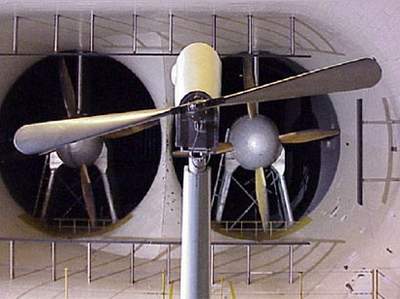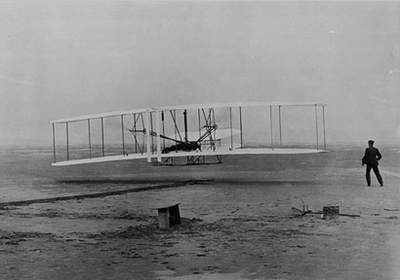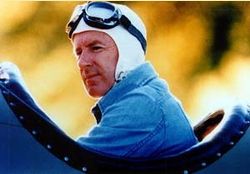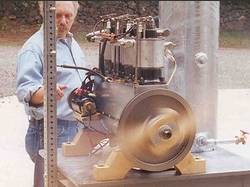Retired Airline Capt. Tries To Duplicate 1903 Flight
For a few moments inside a frigid NASA wind tunnel, Ken Hyde's
quest to replicate the world's first powered airplane felt
complete.
Hand-carved propellers, spinning for the first time on his replica
1903 Wright flyer, whirred like giant pinwheels. Chains turning
shafts clattered in ways unheard for 100 years. The small crowd
watching erupted in applause.
Retired airline pilot Ken Hyde of Warrenton (VA), is building
the flyer that will attempt to duplicate the Wright brothers' first
flight at centennial celebrations in December in Kill Devil
Hills.

Short-Lived Applause
But the work was not done. When the motor stopped, Hyde
dispatched a craftsman to check the rear edge of the top wing. As
Bill Hadden pressed, a metallic pop silenced the clapping. Two
wooden wing ribs had fractured.
"When you've got an airplane that belongs in a museum in an air
tunnel, you're going to have problems," said Kevin Kochersberger, a
mechanical engineering professor at the Rochester Institute of
Technology who is studying Hyde's plane.
Hyde is building the plane that, in December, will attempt to
duplicate the famed Wright brothers' first flight on that very same
spot near the North Carolina coast. This month he towed the nearly
finished aircraft to Langley Air Force Base for tests that could
clarify exactly what the Wrights accomplished in 1903.

It's Never Easy
Nuisances stalked Hyde's team during the first week at Langley
Full Scale Tunnel, a giant, NASA-owned facility built during the
Great Depression to permit engineers to test full-size aircraft
without them leaving the ground.
 No accurate blueprints of the Wright flyer exist.
So Hyde's team, a mix of paid staff, independent researchers and
volunteers, has hunted down surviving plane parts, Wright logs,
writings and photographs for guidance. As problems emerged in
Hampton, they consulted with wind tunnel staff and volunteers -
some veterans of NASA moon and Mars missions - made fixes and moved
on.
No accurate blueprints of the Wright flyer exist.
So Hyde's team, a mix of paid staff, independent researchers and
volunteers, has hunted down surviving plane parts, Wright logs,
writings and photographs for guidance. As problems emerged in
Hampton, they consulted with wind tunnel staff and volunteers -
some veterans of NASA moon and Mars missions - made fixes and moved
on.
Hyde had the entire bottom wing of the plane sheathed in clingy
plastic wrap one night to protect it from raccoons. Just in case,
he left a radio blasting classic rock overnight and set a baited
trap, too. Hyde summoned a fabric conservator to work on the fabric
stains. She had luck with the paw prints.
Harry Combs, formerly a president of Learjet, has commissioned a
second for the National Park Service to display at Kill Devil
Hills. Hyde, who doesn't disclose the cost of his planes, is
looking for a sponsor for the third.
1903 Design. 2003 Testing Methodology
 On Feb. 14, after seven long workdays at Langley,
the first flyer was ready for the hoist onto the tunnel's test
station. Technicians had reconfigured a steel test stand to make
sure the mostly wood and cloth aircraft would hold tight when the
tunnel's two 35-foot-high fans started blowing air.
On Feb. 14, after seven long workdays at Langley,
the first flyer was ready for the hoist onto the tunnel's test
station. Technicians had reconfigured a steel test stand to make
sure the mostly wood and cloth aircraft would hold tight when the
tunnel's two 35-foot-high fans started blowing air.
A ceiling lift on pulleys raised the aircraft about 15 feet and
stopped while all the helpers scrambled up onto the testing floor.
As he ran up stairs, Rawlings noted how much the plane looked then
like the famous rebuilt flyer in the entryway of the National Air
and Space Museum in Washington.
"Only this," he said, "is accurate."
Once attached to the test stand, bathed in the film crew's
carefully placed lights, the flyer looked more like a piece of art
than a machine. Silver bracing wires glistened. Pale muslin
glowed.
Ultimately the tests could settle lingering disputes over
whether the famous Wright flyer was merely a kite with an engine
that was assisted in lifting by winds exceeding 20 mph or a true
airplane capable of taking off on a windless day.
"The underlying feeling is that we're doing something right for
history," said Drew Landman, an engineering professor at Old
Dominion University also studying the aircraft. "The Wrights did a
lot of things, but they could not do this."
 SpaceX to Launch Inversion RAY Reentry Vehicle in Fall
SpaceX to Launch Inversion RAY Reentry Vehicle in Fall Aero-News: Quote of the Day (04.23.24)
Aero-News: Quote of the Day (04.23.24) Aero-News: Quote of the Day (04.20.24)
Aero-News: Quote of the Day (04.20.24) ANN's Daily Aero-Linx (04.20.24)
ANN's Daily Aero-Linx (04.20.24) Aero-News: Quote of the Day (04.21.24)
Aero-News: Quote of the Day (04.21.24)






